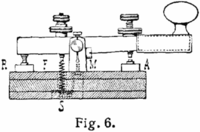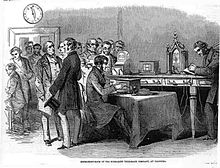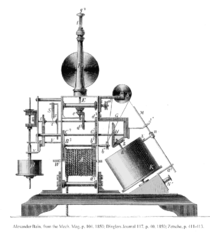Telegraphia
Telegraphia (Graece τῆλε 'distans' + γράφειν 'scribere') est transmissio nuntiorum textualium vel symbolicorum (contra nuntios orales vel sonicos) in longuinquo sine physica rei nuntium ferentis permutatione. Ergo semaphora est ratio telegraphica, sed columba postalica non est.






Telegraphia poscit rationem nuntii per notas adhibiti ab ambobus transmittore et receptore sciendum esse. Tales rationes designantur secundum limites medii pertinentis. Usus signorum fumi, ignium in specula, pharorum, signorum lucis repercussae, et semaphorarum vexilli sunt exempla. Saeculo undevicensimo, moderatio electricitatis ad telegraphum electricum inventum duxit. Adventus radiophoniae annis 1900 ineuntibus radiotelegraphiam at alias genera telegraphiae sine filis effecit. Aetate interretialis magnopere creverunt potestas et facilitas modi telegraphici per interfacies linguae naturalis quae codicem subterraneum celant, res cursuales electronicas, nuntios instantes, et alias technologias praesentes sinentes.
Télégraphe, verbum Francogallicum, a Claudio Chappe, inventore lineae semaphoricae, excogitatum est. Qui etiam verbum sémaphore (semaphora) excogitavit.[1]
Nexus interni
Notae recensere
- ↑ Shectman p. 172.
Bibliographia recensere
- Armagnay, Henri. 1908. Phototelegraphy. Annual Report of the Board of Regents of the Smithsonian Institution 197–207.
- Britton, John A. 2013. Cables, Crises, and the Press: The Geopolitics of the New International Information System in the Americas, 1866–1903. Albuquerque Novi Mexici: University of New Mexico Press.
- Dargan, J. 1985. The Railway Telegraph. Australian Railway Historical Society Bulletin Martio: 49–71.
- Gray, Thomas. 1892. The Inventors Of The Telegraph And Telephone. Annual Report of the Board of Regents of the Smithsonian Institution, 639–659.
- Hochfelder, David. 2012. The Telegraph in America, 1832–1920. Baltimorae: Johns Hopkins University Press.
- Huurdeman, Anton A. 2003. The worldwide history of telecommunications. John Wiley & Sons.
- John, Richard R. 2010. Network Nation: Inventing American Telecommunications. Cantabrigiae Massachusettae: Harvard University Press.
- Kieve, Jeffrey L. 1973. The Electric Telegraph: A Social and Economic History. David and Charles. ISBN 0715358839.
- Pichler, Franz. 2013. Magneto-Electric Dial Telegraphs: Contributions of Wheatstone, Stoehrer and Siemens. The AWA Review 26.
- Ross, Nelson E. 1928. HOW TO WRITE TELEGRAMS PROPERLY. The Telegraph Office.
- Schectman, Jonathan. Groundbreaking Scientific Experiments, Inventions & Discoveries of the 18th Century.
- Standage, Tom. 1998. The Victorian Internet. Berkley Trade. ISBN 0425171698.
- Wheen, Andrew. 2011. DOT-DASH TO DOT.COM: How Modern Telecommunications Evolved from the Telegraph to the Internet. Springer. ISBN 9781441967596.
- Wilson, Geoffrey. 1976. The Old Telegraphs. Phillimore & Co. Ltd. ISBN 0900592796.
Nexus externi recensere
| Vicimedia Communia plura habent quae ad telegraphiam spectant. |
- "Early telegraphy and fax engineering," technikum29.de
- "The History of the Telegraph Companies in Britain between 1838 and 1868," distantwriting.co.uk
- "International Facilities of the American Carriers," www.scribd.com
- Museum Telegraphiae Porthcurno, www.porthcurno.org.uk (maxima mundi statio telegraphica, nunc museum)
- "Telegram Falls Silent Stop Era Ends Stop," www.nytimes.com (The New York Times, 6 Februarii 2006)
- "Western Union Telegraph Company Records, 1820–1995," siris.archives.si.edu (Archives Center, National Museum of American History, Smithsonian Institution)